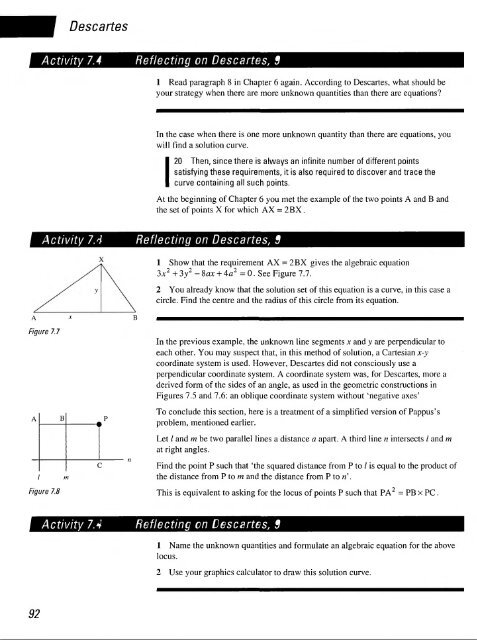history of mathematics - National STEM Centre
history of mathematics - National STEM Centre
history of mathematics - National STEM Centre
Create successful ePaper yourself
Turn your PDF publications into a flip-book with our unique Google optimized e-Paper software.
A<br />
Descartes<br />
Activity 7.7 Reflecting on Descartes, 12<br />
Activity 7.8<br />
Figure 7.7<br />
I m<br />
Figure 7.8<br />
92<br />
1 Read paragraph 8 in Chapter 6 again. According to Descartes, what should be<br />
your strategy when there are more unknown quantities than there are equations?<br />
In the case when there is one more unknown quantity than there are equations, you<br />
will find a solution curve.<br />
1<br />
20 Then, since there is always an infinite number <strong>of</strong> different points<br />
satisfying these requirements, it is also required to discover and trace the<br />
curve containing all such points.<br />
At the beginning <strong>of</strong> Chapter 6 you met the example <strong>of</strong> the two points A and B and<br />
the set <strong>of</strong> points X for which AX = 2BX.<br />
Reflecting on Descartes, 13<br />
1 Show that the requirement AX = 2BX gives the algebraic equation<br />
3x 2 + 3>' 2 - Sax + 4a 2 = 0. See Figure 7.7.<br />
2 You already know that the solution set <strong>of</strong> this equation is a curve, in this case a<br />
circle. Find the centre and the radius <strong>of</strong> this circle from its equation.<br />
In the previous example, the unknown line segments x and y are perpendicular to<br />
each other. You may suspect that, in this method <strong>of</strong> solution, a Cartesian x-y<br />
coordinate system is used. However, Descartes did not consciously use a<br />
perpendicular coordinate system. A coordinate system was, for Descartes, more a<br />
derived form <strong>of</strong> the sides <strong>of</strong> an angle, as used in the geometric constructions in<br />
Figures 7.5 and 7.6: an oblique coordinate system without 'negative axes'<br />
To conclude this section, here is a treatment <strong>of</strong> a simplified version <strong>of</strong> Pappus's<br />
problem, mentioned earlier.<br />
Let / and m be two parallel lines a distance a apart. A third line n intersects / and m<br />
at right angles.<br />
Find the point P such that 'the squared distance from P to / is equal to the product <strong>of</strong><br />
the distance from P to m and the distance from P to n'.<br />
This is equivalent to asking for the locus <strong>of</strong> points P such that PA = PB x PC.<br />
Activity 7.9 Reflecting on Descartes, 14<br />
1 Name the unknown quantities and formulate an algebraic equation for the above<br />
locus.<br />
2 Use your graphics calculator to draw this solution curve.
















